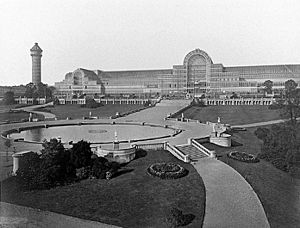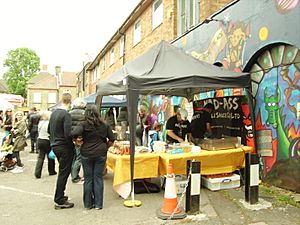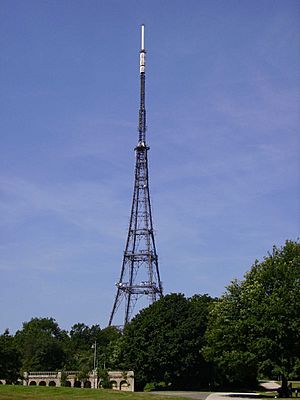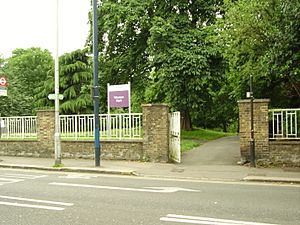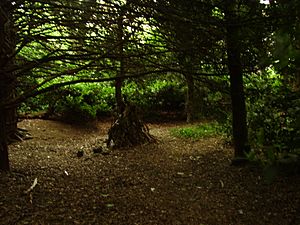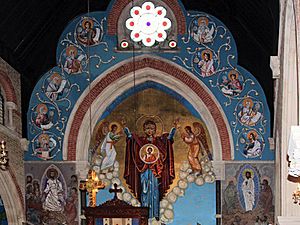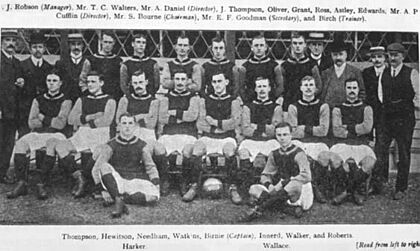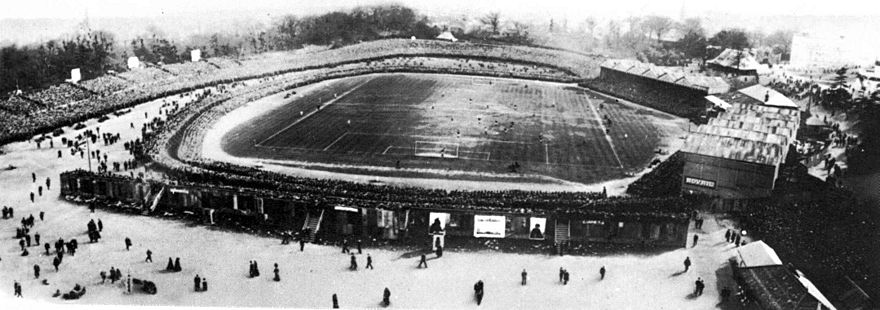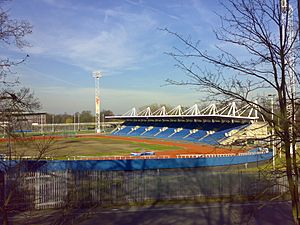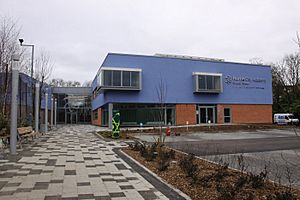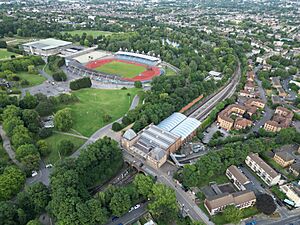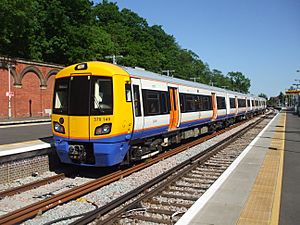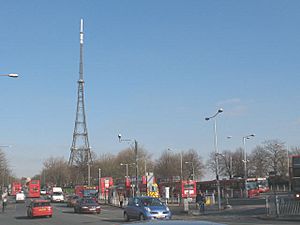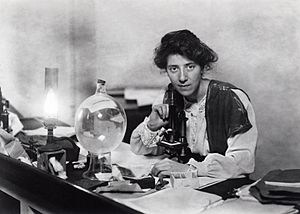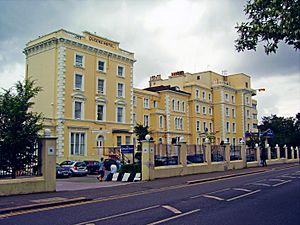Crystal Palace, London facts for kids
Quick facts for kids Crystal Palace |
|
|---|---|
 View of Crystal Palace from the park. Four London boroughs; Bromley, Croydon, Lambeth, and Southwark meet at this junction. |
|
| Population | 12,255 (2011 Census. Bromley Ward) |
| OS grid reference | TQ341708 |
| London borough | |
| Ceremonial county | Greater London |
| Region | |
| Country | England |
| Sovereign state | United Kingdom |
| Post town | LONDON |
| Postcode district | SE19, SE20, SE26 |
| Dialling code | 020 |
| Police | Metropolitan |
| Fire | London |
| Ambulance | London |
| EU Parliament | London |
| UK Parliament |
|
| London Assembly |
|
Crystal Palace is a cool area in South London. It got its name from a huge glass building called the Crystal Palace. This amazing building stood here from 1854 until a big fire destroyed it in 1936.
The area is about 7 miles (11 km) southeast of Charing Cross. It's one of the highest spots in London, at 367 feet (112 meters) high. This means you can get awesome views of the city from here!
Crystal Palace doesn't have exact borders. It spreads across five different London boroughs: Bromley, Croydon, Lambeth, Lewisham, and Southwark. It's also part of a larger area called Upper Norwood. Nearby places include Anerley, Dulwich Wood, Gipsy Hill, Penge, South Norwood, and Sydenham.
Before the 1800s, this area was known as Sydenham Hill. The Norwood Ridge and an old oak tree helped mark the boundaries of different areas. After the Crystal Palace burned down, its land became Crystal Palace Park. This park is now home to the Crystal Palace National Sports Centre, which has a track, stadium, and other sports facilities.
Crystal Palace Park has also been used for concerts and movies like The Italian Job. You can still see two tall TV masts here. They make the area easy to spot from many parts of London. Other cool spots include the Crystal Palace Triangle, a shopping area, and Westow Park.
In 2016 and 2022, the Sunday Times newspaper called Crystal Palace one of the best places to live in London. They said it has a mix of city life and a village feel.
Exploring Crystal Palace's Past
How Crystal Palace Got Its Name
For a long time, this area was covered by a huge natural oak forest called the Great North Wood. It was a popular place for Londoners to visit until the 1800s when more buildings started to appear. The area was also home to Gypsies, and some street names and pubs still remember this link. You can still find parts of the old woodland today.
The Crystal Palace area sits where five London boroughs meet: Bromley, Croydon, Lambeth, Southwark, and Lewisham. It also covers three postcode areas: SE19, SE20, and SE26.
The Amazing Crystal Palace Building
The Crystal Palace was an incredible building designed by Joseph Paxton. It was made from parts that could be put together quickly. This giant iron and glass building was first built in Hyde Park for the Great Exhibition of 1851. This was a huge show of inventions and art from around the world.
After the exhibition, the Palace was moved and rebuilt in 1854. It was made even bigger and placed on the Penge Place estate at Sydenham Hill. The building also housed schools for art, science, and engineering. It attracted visitors for over 70 years!
Sydenham Hill is one of the highest places in London, about 357 feet (109 meters) above sea level. Because the Palace was so big and on such a high spot, you could see it from most of London. This is why the area around it became known as Crystal Palace instead of Sydenham Hill.
Sadly, the Palace was destroyed by a fire on November 30, 1936. The land where it stood is now Crystal Palace Park.
Trains and Transport History
In 1864, a special pneumatic railway (a train that used air pressure) was tested here for a short time. Later, two railway stations were built for the Crystal Palace: a high-level and a low-level station. They were built to handle all the people visiting the big exhibition building.
After the Palace burned down, fewer people used the trains. The high-level station closed in 1954 and was taken down seven years later. For a while, there were even plans to build a big motorway through the area! But now, more people are using the trains again. The low-level station has been updated, and new train services have started.
Cool Places to See in Crystal Palace
The Crystal Palace Triangle
This area is shaped like a triangle, formed by three streets: Westow Street, Westow Hill, and Church Road. It's a lively spot with many restaurants and unique shops. You can find a secondhand market and a farmer's market here too. The triangle also has vintage clothing stores, art galleries, and craft shops.
A cinema called "The Rialto" opened here in 1928 but closed in 1968. After being a bingo hall for many years, it reopened as an Everyman Cinemas movie theater in 2018!
Giant TV Towers
Television signals have been sent from Crystal Palace since the 1930s. Two tall TV transmitter towers stand on the hill in Upper Norwood. The Crystal Palace Transmitter is 640 feet (195 meters) tall, and the Croydon Transmitter is 500 feet (152 meters) tall. These towers make the area a famous landmark that you can see from many parts of London. The Crystal Palace mast was built in 1956 and is on slightly higher ground.
Crystal Palace Park
Crystal Palace Park is a huge Victorian park that covers much of the Crystal Palace area. It's one of London's main public parks. The park used to be managed by big London councils, but since 2023, the Crystal Palace Park Trust takes care of it.
The Crystal Palace railway station and the Crystal Palace National Sports Centre are right next to the park. In the past, the park was used for sports like cricket and football, and even motor racing! It's also a popular place for concerts and music festivals today.
One of the coolest things in the park are the famous Crystal Palace Dinosaur sculptures. They are giant models of dinosaurs that were built in the 1850s!
The park is on the Norwood Ridge, which is a high point. From here, you can see amazing views of central London, Greenwich, Croydon, and the North Downs. The park is also a starting point for the Green Chain Walk, a path that connects to other green areas.
Westow Park
This is a smaller park, about 2.73 hectares (6.75 acres) in size. It's located southwest of the Crystal Palace Triangle. Every summer, Westow Park hosts the Crystal Palace Overground festival, a free community event.
Stambourne Woods
South of the triangle is a small wooded area called Stambourne Woods, covering about 1.92 hectares (4.75 acres). It has a lovely path called the Stambourne Woodland Walk, which opened in 1984. This area used to be the gardens of old Victorian houses. The paths and benches were added, but much of the natural plants were left alone, creating a beautiful woodland trail.
Saint Constantine and Helen Greek Orthodox Church
At 69 Westow Street, you'll find a beautiful Greek Orthodox Church. It was built in 1878 and used to be an Anglican church. Now, its walls are decorated with amazing Byzantine-style art.
Sports in Crystal Palace
Crystal Palace Football Club
The Crystal Palace Football Club was started in 1905. They first played their home games at the sports stadium inside the Crystal Palace grounds. But in 1915, during the First World War, they had to move. They played at other nearby places before moving to their current home, Selhurst Park, in 1924.
FA Cup Final History
The FA Cup Final, a very important football match, was held at the Palace sports stadium every year from 1895 to 1914.
The stadium also hosted the first rugby match between England and New Zealand in 1905. New Zealand won that game 15-0. A cricket club, the London County Cricket Club, also played their matches here.
National Sports Centre
In 1964, a large athletics stadium and sports center were built in Crystal Palace Park. This place is called the Crystal Palace National Sports Centre. It has a stadium with 15,500 seats. From 1999 to 2012, it hosted big international athletics events like the London Grand Prix. The Crystal Palace triathletes club also trains here.
After the London 2012 Olympics, new sports facilities were built in London. Because of this, Crystal Palace F.C. has suggested plans to rebuild the stadium into a 40,000-seat football stadium.
Motor Racing Circuit
A motor racing track opened around the park in 1927. Parts of this old track are now used as access roads in the park. The track was made longer in 1936. During World War II, the military took over the area.
Races started again in 1953, and the circuit hosted many international racing events until 1974. For a few years starting in 1997, parts of the circuit were used for a special sprint race once a year. This event started again in 2010 and continued until 2019.
Learning in Crystal Palace
Crystal Palace has three primary schools: Paxton Primary School, Rockmount Primary School, and All Saints C of E Primary School. There is also one secondary school, Harris City Academy.
Crystal Palace Park has a branch of Capel Manor College. Here, you can take courses in animal care, tree care, gardening, and garden design.
Getting Around Crystal Palace
Roads
Main roads like the A212, A214, A234, and A2199 serve the area. The streets that form the Crystal Palace Triangle (Westow Hill, Westow Street, and Church Road) are part of a one-way system. There's also a coach park inside Crystal Palace Park.
Cycling
London Cycle Network routes 23 and 27 pass through Crystal Palace. Route 27 goes from Anerley Hill through part of Crystal Palace Park towards Bromley. Route 23 goes through the Crystal Palace triangle to connect to Borough and Croydon.
Transport for London has also planned a "Quietway" route 7. This route would go from Crystal Palace to Elephant and Castle, making it easier and safer to cycle.
Trains
You can get to Crystal Palace by train at Crystal Palace railway station. Southern trains run to Victoria and London Bridge. London Overground trains go to Highbury & Islington. Southern services also go to Beckenham Junction, Sutton, and Epsom Downs.
Crystal Palace station is special because it's on the border of two fare zones, Zone 3 and Zone 4. The south side of Crystal Palace Park can be reached by train via Penge West.
Crystal Palace used to have another train station, the Crystal Palace (High Level) railway station. It was built for visitors to the Crystal Palace. But after the fire in 1936, fewer people used that train line. The station closed in 1954 and was taken down in 1961. Even though the station is gone, a Grade II listed subway (an underground walkway) still remains under Crystal Palace Parade.
The low-level station stayed open, but fewer people used it after the 1936 fire. In the 1960s and 1970s, train travel was declining across the UK. However, in recent years, more people are using the trains again.
Since May 2010, the station has been part of the East London Line of the London Overground. This connects Crystal Palace to the Docklands and Shoreditch. In 2011, services were extended to Highbury and Islington. The station was updated in 2012. The old Victorian ticket hall was brought back into use, a new cafe was added, and three lifts were installed to make it easier for everyone to access the platforms.
Buses
Many bus routes serve Crystal Palace. A lot of them end at Crystal Palace Bus Station, which is on the Parade. These include routes like 3, 122, 157, 227, 249, 322, 358, 410, and others.
Airports
The closest big international airports are Heathrow and Gatwick. London City Airport and Biggin Hill Airport are also nearby.
Famous People from Crystal Palace
- Joseph Paxton, who designed the Crystal Palace, lived in a house called "Rockhills" on Westwood Hill.
- Benjamin Waterhouse Hawkins, the artist who created the Crystal Palace Dinosaurs in the park, lived nearby.
- Jim Bob, the lead singer of the band Carter USM, lives in Crystal Palace.
- The famous African-American Shakespearean actor Ira Aldridge lived on Hamlet Road.
- The French writer Émile Zola stayed in what is now the Queen's Hotel on Church Road in 1898-1899. He had to leave France after a legal issue.
- Francis Pettit Smith, one of the inventors of the screw propeller for ships, lived in the area.
- British rapper Speech Debelle was born in Crystal Palace.
- Camille Pissarro, a famous Danish-French Impressionist painter, stayed in Crystal Palace in 1870-1871.
- Comedy writer John Sullivan, who created the show Only Fools and Horses, wrote his first sitcom pilot while staying in Crystal Palace.
Nearby Places
- Anerley
- Beckenham
- Catford
- Dulwich and Dulwich Wood
- Elmers End
- Forest Hill
- Gipsy Hill
- Penge
- South Norwood
- Sydenham
- Upper Norwood
- West Norwood
See also
 In Spanish: Crystal Palace (Londres) para niños
In Spanish: Crystal Palace (Londres) para niños



